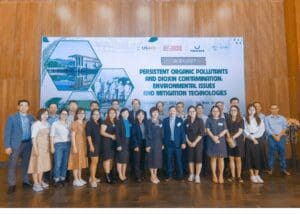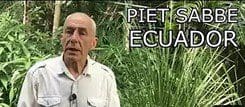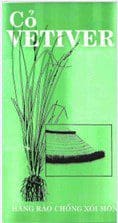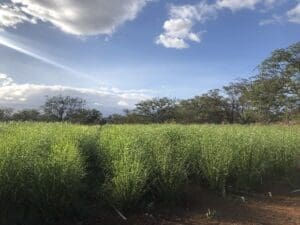NEWS UPDATE
ICV7. It looks as though everything is on track. Nongpun Kolosolak and her team at the Office of Royal Development Projects Board are working hard at organizing the conference that will be held in-person and online. The Registration platform is working and can be accessed at . The evaluation of the King of Thailand Vetiver Awards have been completed and are now in the hands of the organizers. TVNI Awards have a longer time frame for evaluation. If you haven’t made a submission for the TVNI awards and you want to go to this link .
Dr Rattan Lal is the Distinguished University Professor of Soil Science at Ohio State University, and Director of the University’s Carbon Management and Sequestration Center. He is the recipient of the World Food Prize for 2020. We are honored that he has accepted the invitation as keynote speaker at ICV7. His presentation “Managing Soil Health by Vetiver-Based Farming Systems for Climate and Food Security” should be of great interest and fits well with our current initiatives relating to Regenerative Agriculture with Vetiver (RAV). In a recent exchange Dr. Lal writes —
“… Soil erosion control is a major part of soil carbon sequestration and restoration of soil health. Thus, Vetiver is important to sequestering carbon through conservation of soil and water in the root zone and minimizing the risks of transport of soil organic matter out of the watershed. Therefore, I am looking forward to the conference in Thailand because Vetiver provides a common thread to addressing the issues of soil and water conservation and adaptation/ mitigation of anthropogenic climate change.”
 The International Center for Interdisciplinary Science and Education (ICISE) hosted a workshop in Vietnam on “Persistent Organic Pollutants and Dioxin Contamination: Environmental Issues and Mitigation Technologies” from February 10-12, 2023. This event provided a platform for experts in environmental science and biotechnology to exchange knowledge on the topic of dioxin and persistent organic pollutants contamination, as well as the potential impacts and the latest Vetiver application in the remediation and treatment of dioxin (Agent Orange) polluted land.
The International Center for Interdisciplinary Science and Education (ICISE) hosted a workshop in Vietnam on “Persistent Organic Pollutants and Dioxin Contamination: Environmental Issues and Mitigation Technologies” from February 10-12, 2023. This event provided a platform for experts in environmental science and biotechnology to exchange knowledge on the topic of dioxin and persistent organic pollutants contamination, as well as the potential impacts and the latest Vetiver application in the remediation and treatment of dioxin (Agent Orange) polluted land.
THE NEED TO DEVELOP NATIONAL BASED VETIVER PROGRAMS
 Our friend, and in my view one of the best project development managers who I have had the privilege of knowing, the late Criss Juliard, wrote the following 23 years ago in a paper presented at the Second International Vetiver Conference, Thailand, January 2000 .
Our friend, and in my view one of the best project development managers who I have had the privilege of knowing, the late Criss Juliard, wrote the following 23 years ago in a paper presented at the Second International Vetiver Conference, Thailand, January 2000 .
“If Vetiver Grass Technology is so simple, inexpensive and good for the health of the soil, why isn’t it promoted more broadly on a national scale in the same way vaccinations are promoted to preserve an individual’s health? The answer is not related to the attractiveness of the technology, but to the challenge of dissemination. Madagascar is a best-case experience where a need to protect roads, safeguard hillsides, and improve poor agricultural soils in a particular area helped catalyze and shape a broad-based, national vetiver dissemination program. This program appears to have led to the sustainability of the technology. The Madagascar approach evolved over a three-year period and consisted of actions that a) brought interested people and organizations together committed to vetiver, b) insured reliable and timely supply of vetiver plants to end-users, and c) applied vetiver technology according to site-specific needs. The approach was low cost, involved information campaigns, used demonstration sites for practical applications, and benefited from research and applications developed in other countries. Success can be attributed in part to close relationships with the four target groups in the vetiver communications and implementation plan: a) village associations, b) private producers, c) local elected officials, and d) professional organizations, ministries and donors. Lessons learned from the Madagascar program could prove useful to practitioners hoping to establish a broad-based and sustainable vetiver program elsewhere.”
The answers remain much the same as they did then, the need is much greater – we have to work harder at it!.
VETIVER VIDEO IN SPANISH

This video that was the overall global winner of TVNI/ORPDBs short video competition has now been dubbed in Spanish. The explains in two steps how farmers can apply Vetiver grass barriers on slopes in order to stop soil erosion and improve the soil. The video, authored and produced by Piet Sabbe of Ecuador, was the Global winner of TVNI’s short video competition, the original has English audio.
VETIVER GRASS – A HEDGE AGAINST EROSION
The best guide for farmers and gardeners. (English)
 A farmer’s handbook about vetiver grass farm applications authored by John C. Greenfield, and first published 35 years ago is now available as a free down load VIETNAM , SWAHIILI, BENGALI, INDONESIAN, CHICHEWA (Malawi, parts of Mozambique and Zambia) and VIETNAMESE. All these versions read well on a smart phone. Go to Manuals/Guides for versions in other languages and different vetiver guides and brochures. Amongst these is a version of John Greenfield’s handbook with photos to match the line drawings of the original – see “The Vetiver System for Soi and Water Conservation”
A farmer’s handbook about vetiver grass farm applications authored by John C. Greenfield, and first published 35 years ago is now available as a free down load VIETNAM , SWAHIILI, BENGALI, INDONESIAN, CHICHEWA (Malawi, parts of Mozambique and Zambia) and VIETNAMESE. All these versions read well on a smart phone. Go to Manuals/Guides for versions in other languages and different vetiver guides and brochures. Amongst these is a version of John Greenfield’s handbook with photos to match the line drawings of the original – see “The Vetiver System for Soi and Water Conservation”
VETIVER FARM: SOIL MANAGEMENT FROM A SMALL FARMER
Jesus Gomez
Mr. Gomez is a small farmer dedicated to organic production for more than 10 years. He and his family produces vegetables and medicinal and aromatic plants for local market.
…… The first terraces were built with stones and bamboo but failed due to the cost and poor durability. Then, Mr. Jesus Gomez tested the use of plants like vetiver, citronella, and King grass. He chose to work with vetiver grass (Chrysopogon zizanioides) because it formed terraces in a natural way and, among other advantages the leaves could be used for composting . After more than 10 years of continuous work with vetiver grass, Salamanca Gomez family helped to establish a farmers association the members of which replicated Vetiver Farm’s experience and practices. Ecological management of soil has enabled Salamanca Gomez family to maintain a steady production of vegetables and fruits sold in the organic local market in the city, providing the family’s main source of income.
Vetiver Farm, Salamanca Gomez family, is located 30 minutes from the city of Cali (Colombia), and has a total area of 11.5 hectares of medicinal plants, aromatic plants, fruits and vegetables, such as lettuce (several varieties), spinach, celery, parsley, cilantro, strawberry, mint, cidron, thyme and basil. All grown on terraces to reduce erosion risks, maintain and improve soil fertility naturally, and keep plants strong and resistant to pests and diseases (trofobiosis theory/ soil and plant health). This has been the basis for the ecological management of the property for the last 15 years, practices that have been extended to other producers, students, professionals and public sector representatives.
Vetiver Farm has 67 terraces, each 70 m (long). The vetiver grass naturally creates the terrace riser. On each terrace, is planted between 2 and 3 commercial crops (like lettuce) together with medicinal and aromatic plants to reduce the incidence of pests. In addition to the natural fertility accumulated on the terrace, compost produced with chicken manure, crop residues and rock minerals, among others are applied to the soil. Jesus Gomez is promoting a technique named “biological machine” that consists is in situ decomposition of crop residues….”.
BIOROPE
A n innovation by Alois Kennerknecht of Peru <[email protected]> See a photo essay for pictures.
n innovation by Alois Kennerknecht of Peru <[email protected]> See a photo essay for pictures.
“…. The creation of the biorope was the result of a search to stabilize land on roadsides without using plastic bags filled with soil. There was Vetiver straw available and people looking for work during COVID times. Two jobless cooks qualified to braid the rope. We used the biorope in stony ground with great success. The application of the biorope while planting vetiver in the Bicentennial Park, a public works project in Miraflores, was decisive for total success in the face of the anti-technical and corrupt orders of the project’s management personnel. With a request for vetiver in the 100% desert area 160 km south of Lima, we applied the biorope and were able to confirm its great potential for saving the amount of watering and the benefits to the development of vetiver roots. In addition, the use of the “irrigation drill” was an unbeatable complement for planting vetiver in the desert. The drill is not indispensable, but it helps a lot in water economy and with the fast and deep development of the roots. It provides a water reservoir that the sun does not have access to evaporate. The three positive experiences with this method ensure the great potential that the biorope offers in response to the need to combat erosion and create green areas worldwide. Since we have tested the usefulness/benefits of the Biorope, we are already applying it in the projects we carry out with great success. We already have a stock of 3 km of biorope prepared for customers. For our clients in the provinces we train them remotely.”
and Aloise has been testing Vetiver on Lake Titicaca …
“I have experience growing vetiver over 3300 meters above sea level through clients since 10 years. This was the impetus to try growing vetiver on Lake Titicaca (over 3,800m asl), which never freezes and has year-round sunshine. The daytime is also longer (light is very important for vetiver) than in the other parts of Peru. So I looked for a connection to install vetiver on the Lake Titicaca and it worked”.
WASTE WATER TREATMENT IN MAUI, HAWAII
Maui Wastewater Treatment Plant.
A note from John Astilla – John has built up his expertise over a number of years now, and it is wonderful to see him moving into waste water treatment where vetiver has some very useful applications both for public and domestic purposes. ( I also see that from a recent news article that there is a program focusing on point source erosion locations in western Maui where vetiver will be on of the “tools” used for mitigation).
“…….. business has been steady with wholesaling vetiver plant material to landscapers. I haven’t been doing any installations, but provide consultation to installers.
 The pilot project in Kihei, testing the disposal capacity of vetiver and R1 recycled water is ongoing. This April 2023 marks 2 years
The pilot project in Kihei, testing the disposal capacity of vetiver and R1 recycled water is ongoing. This April 2023 marks 2 years  since installation. It is a 15,000 sq ft plot, drip irrigated with R1 water from the Kihei Wastewater Facility. The site receives roughly 7,000 gallons per day which is equivalent to 20,380gl/acre/day. During a 4 month stress test of the system I increased the irrigation rate to approximately 30,000gl/ac/day. Even at that high application rate and time period, there was no significant ponding or runoff coming from the site. We pitched the concept to the mayor and County Council. All seemed interested in the project, but a site for surface disposal isn’t available. The wastewater facility is surrounded by private ranch land, and the land owners have other long term plans for their property. The pictures attached
since installation. It is a 15,000 sq ft plot, drip irrigated with R1 water from the Kihei Wastewater Facility. The site receives roughly 7,000 gallons per day which is equivalent to 20,380gl/acre/day. During a 4 month stress test of the system I increased the irrigation rate to approximately 30,000gl/ac/day. Even at that high application rate and time period, there was no significant ponding or runoff coming from the site. We pitched the concept to the mayor and County Council. All seemed interested in the project, but a site for surface disposal isn’t available. The wastewater facility is surrounded by private ranch land, and the land owners have other long term plans for their property. The pictures attached
Over the past several months I have been working to identify and map County, State and Private land that has access to the R1 water distribution system. Once these areas are identified I can assess which parcel may be ideal for a small vetier disposal system. So rather than having a centralized, contiguous 100 acre parcel for disposal, my concept decentralizes disposal with small vetiver sites spread out along the distribution system. I am hoping to have disposal areas identified this year and begin approaching the land stakeholders with this concept.
Bioreactor Garden
I have also partnered with a non-profit group called Ridge to Reefs, based out of Maryland. Since 2015, Ridge to Reefs has been able to secure funding for a number of vetiver erosion control projects in West Maui. In 2020, Ridge to Reefs secured funding to pay University of Hawaii’s Water Resource and Research Center to test a home waste water disposal system that we innovated to be an alternative to septic and cesspool systems. We call it the Bioreactor Garden. It comprises a proprietary blend of media that filters and denitrifies the effluent and is planted with vetiver to dispose the effluent. The system was tested at the East Honolulu Wastewater Facility and passed its performance test and received certification for NSF40 and NSF245. A colleague of mine on Maui, and 2 members of Ridge to Reefs have created a new entity called Nature Based Solutions. Under NBS, we are working to implement the first Bioreactor Gardens in Hawaii and work with the local government to develop a surface disposal system for R1 recycled water. We currently have 1 design under review by the Dept of Health which upgrades an existing septic system with a bioreactor to bring it as close to zero discharge as possible. We have another project in the design phase that converts a home cesspool to a bioreactor garden. I can update you as this new phase of my vetiver work evolves.
Great ideas and innovations. The dispersed vetiver wetlands could provide nice habitat for birds and other wildlife. The Biogardens could have a large market if successful, and I am sure that they will be, and they are needed by many domestic homeowners. Ed
RESEARCH
FLOATING VETIVER ISLAND (FVI) AND IMPLICATION FOR TREATMENT SYSTEM DESIGN OF POLLUTED RUNNING WATER
Kusin, F. M.– Hasan, S. N – Nordin, N. A – Mohamat-Yusuff, F.Ibrahim, Z. Full paper
Abstract. Floating Vetiver Island (FVI) system has been investigated in this study as a relatively new technology of artificial wetland treatment. Vetiver grass (Vetiveria zizanioides) was used as the treatment vegetation in the FVI owing to its high tolerance to various types of contaminants. Performance of the FVI was tested on actual polluted running water having characterized by a Class III-Class IV river according to water quality index (WQI) classification. Field trial of FVI over a six-week installation demonstrated an improved water quality with significant increase (92%) of dissolved oxygen and great removals of chemical oxygen demand (77%) and nitrate (73%), resulting in 14% increase of the overall WQI. It was proposed that treatment system performance for FVI can be reflected by the number of pontoons (FVIs) and treatment distance required to achieve desired water quality improvement. The calculated pollutant removal rates were incorporated into the estimation of treatment system requirements. Field installation guide for FVI system is also presented along with treatment system maintenance. For such an FVI system, vetiver grass pruning (trimming) at 2-month intervals is recommended for promoting the growth of the plant and for medium- to long-term FVI performance.
Some reference photos — Vetiver Pontoons For Wastewater Treatment In Storage Ponds by Dr. Paul Truong. Rule of thumb! — 100 plants 75 m3 of water ?
Comparative effects of vetiver grass (Chrysopogon zizanioides) strips, vetiver mulch and veticompost on soil quality and erodibility of a sloping land [2012]
Are, K.S., Obafemi Awolowo, Adelana, A.O., Obafemi Awolowo ,Adeyolanu, O.D., Obafemi Awolowo, Oyeogbe Source
This study investigates the influence of vetiver grass strips (VGS), vetiver mulch (VGM) and composted vetiver prunes (veticompost) on soil quality of an eroded land in the Institute of Agricultural Research and Training, Ibadan, Nigeria. The treatments were 3-m wide VGS established at 10-m inter-row spacing, VGM imposed at 5 Mg/ha, veticompost applied at 5 Mg/ha and a control (no-vetiver grass). All quality indicators including physical, chemical and biological indices and soil erodibility (K) factors were determined between 2008 and 2011. Results show that soil organic matter (SOM) and associated nutrients play a major role in soil quality variation. VGM had the highest impact on soil quality (76.5%) but not significantly different (P less than 0.05) from veticompost (72.5%). Soil quality ratings were in the order of VGM, veticompost, VGS and control. Significant and positive relationship exist between soil quality ratings and maize yield, with 70% of grain yield variability accounted to the soil quality. K factor ranged from 0.013 to 0.030 Mg h/MJ/mm with the VGM and control plots having the least and highest K factors, respectively. Although the soil quality under veticompost is lower than vetiver mulch but the SOM and associated nutrients under veticompost enhanced better soil productivity, and thus accounted for higher crop yields than other treatments.
Allelopathic effects of vetiver grass on weeds [1996]
Thiamjai Komkris; Suchada Sripen; Sombun Techapinyawat. Source
Vetiver is a tropical perennial grass, widely distributed thoughout Thailand Vetiver is cultivated for erosion control as well as a sort of barrier to prevent the invasion of weeds. Experiments were performed to investigate allelopathic effects of vetiver grass on weeds. Methanol extract of ground dried stems and roots of 3 vetiver ecotypes were tested on 10 common weed species. It was found that root and stem extracts from 3 vetiver ecotypes Ratchaburi, Suratthani and Indonesia strongly inhibited seed germination and seedling growth of Amaranthus gracilis Desf., Abutilon hirtum Sweet. Pennisetum polystachyon Schult., Melochia corchorifolia Linn. and Ruellia tuberosa Linn. The degree of inhibition was vetiver ecotypes, concentration of the extracts and weed species dependent. The study also suggests the possibility of developing a natural herbicide from vetiver grass which will leave hopefully little of no toxic residue harmful to the environment.
Environment and socio-economic values of vetiver; A miracle grass [1996]
Huq, Fazlul et al source
Vetiver is a familiar grass growing in the flood plain soil of Bangladesh. It is commonly grown as a fodder in the rural areas. In the rural condition, this grass has high economic value. The Vetiver is a first growing species of indigenous fodder. The plants become 2-3 feet high with leaves and soft body. The leaves and stems are soft and palatable to the animals. The marshy and wet land is favourable for vetiver cultivation. The small scale dairy and livestock farmer cultivate this grass in their limited Agricultural land in between two principal crops. Sometimes Vetiver is cultivated as a relay crop. The vetiver has high nutritive value for Dairy crops and Beef faltening animals. The goat and sheep herders also use the fodder as a popular forage. The animals with other balance feed and vetiver show a remarkable body of gain within a short period. Small scale farmers benefit both socially and economically. The cultivation of vetiver helps both soil erosion and fertility of the land which gives environmental protection. So the socio-economic value of vetiver is quite satisfactory for the poor farmers in a country like Bangladesh.
Reducing Ammonia And Chromium Concentration In Batik Wastewater By Vetiver (Chrysopogon Zizanioides L.) grown In Floating Wetland
Effendi, H. – Margaretha, J. A. – Krisanti, M. Source
Abstract. Waste of batik industry that is not well processed potentially contaminate the aquatic environment. Liquid waste concentration of 0%, 50%, 75%, and 100% was applied to vetiver (Chrysopogon zizanioides L.) grown in floating wetland system for treatment of batik industry liquid waste. Research was conducted in Akademi Kimia Analis (AKA) Bogor, Indonesia. This study aimed to determine the ability of vetiver for reducing the concentration of NH3 and NH4+, TAN, BOD, COD, and total chromium. 50% of batik waste water was revealed to be the most suitable concentration treated by
vetiver in floating wetland, since it could reduce not only ammonia, confirmed by biplot analysis, but also 40.29% total chromium concentration
A Vetiver Hedge Alignment tip!
 When laying out vetiver hedgerow on the contour there is no need to follow the contour exactly, instead average it out (yellow line) so that it easier to work the land. Low spots will fill up with sediment over time. On occasion you may neeed to add some extra protection in the low spot (double vetiver line, earthbag, leaf cuttings)
When laying out vetiver hedgerow on the contour there is no need to follow the contour exactly, instead average it out (yellow line) so that it easier to work the land. Low spots will fill up with sediment over time. On occasion you may neeed to add some extra protection in the low spot (double vetiver line, earthbag, leaf cuttings)
Previous Newsletters
Regarding vetiver mulch, strips and vermicompost, is it practical/economical to weave vetiver grass into mats for use as mulch, as an alternative to plastic mulch?
This description of fragmenting plastic mulch given in this article was so disturbing.
‘China Increasing Agricultural Production on a Sea of Plastic’ Apr 16, 2020 by Karen Mancl
RIchard GRIMSHAW
I think I have seen a photo of a machine in China that creates large rolls of rice straw mats that could be rolled out as mulch see: https://www.alibaba.com/product-detail/Rice-straw-plate-bamboo-straw-making_1600175980705.html However the economics might be doubtful. Might be good for row crops (vegetables, fruit etc).